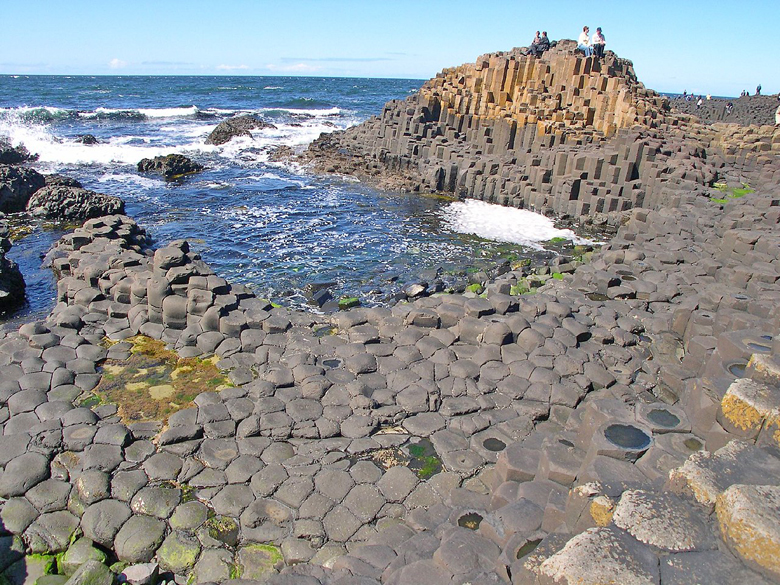Giant’s Causeway is a spectacular rock formation on the Antrim coast of Northern Ireland. The site consists of some 40,000 basalt columns rising out of the sea. The Giant’s Causeway is Northern Ireland’s only UNESCO World Heritage Site.
Myth : Popular mythology attributes the creation of the Causeway to an Irish giant named Fionn mac Cumhaill. To prove his superior strength and status, Fionn decided to fight against a rival Scottish giant named Benandonner. As there was no boat large enough to carry huge Finn across the sea to confront Bennandonner, he built his own pathway of stepping stones from Ireland to Scotland. He then was able to walk across the sea without getting his feet wet. When he crossed the sea, however, he saw just how large Benandonner was. He ran back to Ireland before Bennandonner saw him, but the causeway was built and Bennandonner came to fight. Fionn crawled into a crib and when Bennandonner came to the door to fight him, his wife told him not to wake the baby. Seeing just how large Fionn’s “baby” was, Bennandonner grew afraid and ran back to Scotland, tearing up the causeway as he went to prevent Fionn following him.
Scientific explanation : The true explanation while not as colorful as the myths of yore is still quite interesting. Scientists now agree that about 60 million years ago a volcano let basalt come to or close to the surface that slowly cooled forming the polygon-shapes as the hot material contracted due to cooling. The hexagonal shape is most common as it is the most “efficient” way to “pack” material (just as it is in a beehive). Later erosion formed the current structure, as the basaltic material forming the pillars is more resistant to erosion than other material. Similar structures (though in less impressive locations) can be found throughout the world.
Access : Coordinates: 55.240833, -6.511667 / By bus or train : There is bus service during the summer this is the 402 causeway Rambler (which costs £6) Departs Coleraine Bus/Rail station at other times of the year from late September to the spring time you will have to use the 172 service that runs from Coleraine Bus/Rail centre to Ballycastle via the Giants causeway (timetable will be marked “Aird the nook Giants causeway”) all public transport info can be found at www.translink.co.uk (click journey planner), you can get there by train from Belfast by taking the train to Coleraine (1 hr 20 min ) and getting off the train in Coleraine and going into the train/bus station (under the same roof), getting the bus 402 Causeway coast Rambler (April to September) and the 172 bus to Ballycastle (rest of the year).
By car : From Belfast, follow the signs for the “Giant’s Causeway Coastal Route” for a beautiful scenic route to the Causeway. It takes a longer (around 2 hours depending on traffic) but it is worth it for the views. There is also the more direct route along the A26 from Belfast or the A2/A37 from Derry/Londonderry if time is a factor. By rail : A small railway line the Giant’s Causeway and Bushmills Railway from the village of Bushmills to the train station near the site of the Giant’s Causeway. The railway used three trains, two of which are steam trains. The route goes though Bushfoot Strand down, Crossing Bushfoot Golf Course and Portballintrae.
Attractions : The focal point of the area is, of course, the Giant’s Causeway. There is no charge for visiting the causeway, although you will find that parking costs a little more than you would expect (circa £6). This is a free site, so a car with four people works out quite reasonable. Cheaper still, check out the near-by Causeway railway carpark (circa £4) or park on the verge of the main road (free!) It is an interesting site to see but come prepared for a long and intense walk. Best to wear waterproof clothing and strong footwear. Giant’s Causeway is split up into six sections in walking order:
The Camel , The Granny, The Wishing Chair , The Chimney Tops , The Giant’s Boot.
The Organ.
All six parts of the Giant’s Causeway are different in shape and form and truly are a sight to be seen.

